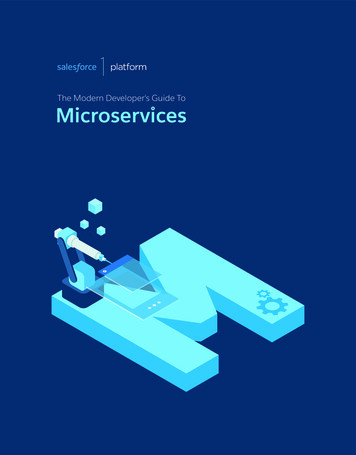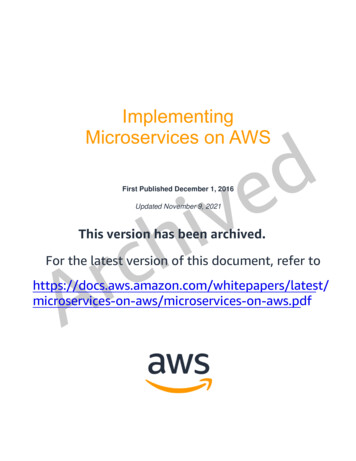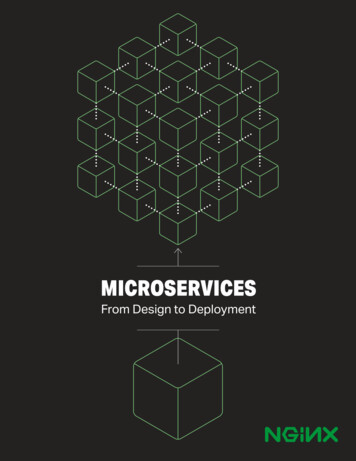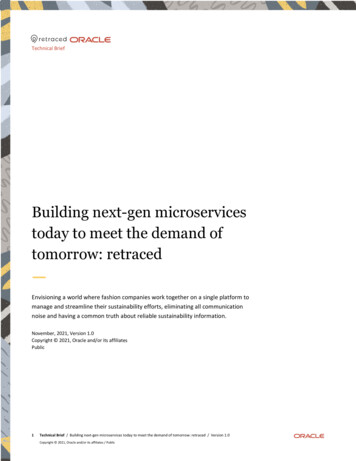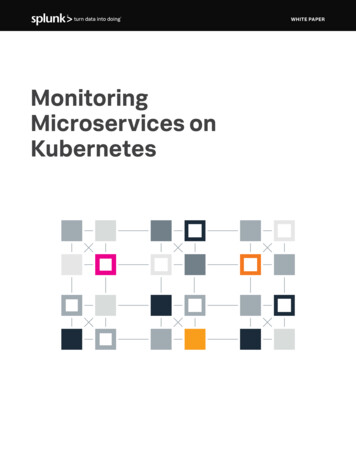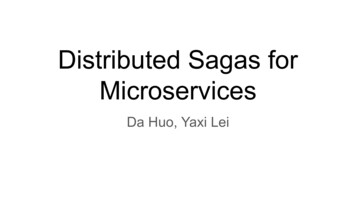
Transcription
Distributed Sagas forMicroservicesDa Huo, Yaxi Lei
Overview Challenges of microservices architecturesWhat is “Saga” and where does the term come fromIntro to distributed sagas ComponentsCharacteristicsImplementation ApproachesAWS Step Functions as a Saga Execution CoordinatorDetailed case study of distributed sagas
The ProblemBenefit of Microservices Architecture: ScalabilityFlexibilityProductivity.Challenges with Microservices Architecture:It is hard to maintain the correctness & consistency in a distributed transaction
What is a transaction?A set of operations that need to be performed together In monolithic systems: Use a single relational database to maintain ACID semanticsFailure is all-or-nothingIn microservices based systems: Different components/services can failHard to maintain correctness and consistency
Example of Distributed Transaction
What if one of the services has failed?
2 Phase CommitPhase1: Coordinator ask all participants tovote if ready to commitParticipants votePhase2: If all participants voted yes Allparticipants commitIf any voted no All participantsabort
Problems with 2PC 2PC does not scaleO(n 2) messages required in worst caseThroughput is limited by the slowest node in the clusterCoordinator is a single point of failure
Distributed Sagas A protocol for coordinating microservicesA way to ensure data consistency in a distributed architecture without havinga single ACID transaction
Where does the term “Saga” come from? The term Saga was first used in a database systems research paper in 1987
Challenges with DBMS in 1987 Long lived transactions hold on to database resources for a long period oftime causing the delay of other lighter and more common transactions Lock resources for the entire duration of transactionOther transactions have to wait until the long lived transactions to finishedExample of long lived transactions: Produce monthly bank statements at a bankCollect statistics over the entire database
Solution Find and break sagas into a set of sub-transactionsExecute sub-transactions and lock resources separatelyIf any sub-transaction failed, execute compensating transactions for theircorresponding completed sub-transactions A compensating transaction semantically undoes its corresponding transactionsCovered in detail in later slides
What is a Saga? In DBMS:A saga is a long lived transaction that can be broken up into a collection ofsub-transactions that can be interleaved in any way with other transactions In Distributed Systems / Microservices:A Saga represents a high-level business process that consists of severallow-level Requests that each update data within a single service
Book Trip is a Saga consists of Book car, Book hotel, and Book flight
Distributed SagasA distributed saga contains 2 parts: A collection of requests Example: Book hotel, Book car, Book flightCompensating requests for each request Semantically undoes it’s corresponding requestCancel hotel, Cancel car, Cancel flight
Characteristics of distributed sagas requests Requests can abort (service can reject a request at any time)Requests must be idempotentCharacteristics of compensating requests Compensating requests CANNOT abortCompensating requests must be idempotentCompensating requests must be commutative Book hotelCancel hotel Cancel hotelBook hotel
Guarantees of Distributed SagasWith distributed sagas, one of the follow two outcomes will happen:1.2.All requests are successfully completedA subset of requests and their compensating requests are executed
Distributed Sagas Implementation Approaches1.2.Event-driven choreographyOrchestration
Event-driven choreography No central coordinationEach service will produceand consume to events ofother services and decidewhat actions to take
Benefit of Event-driven choreography Does not require additional coordinator logic implementation andmaintenanceNo single point of failureDrawbacks of Event-driven choreography Workflow can be confusing as the microservice architecture gets increasinglycomplexRisk of cyclic dependency between services (A consumes events from B, Bconsumes events from A)
Orchestration A centralized coordinator service is responsible for decision makingCoordinator stores and interprets Saga’s current stateCoordinator tells services what requests to executeCoordinator handles failure recovery by executing compensating requests
Benefit of Orchestration Clear workflow for complex systems with many participantsDoes not introduce cyclic dependenciesDrawbacks of Orchestration Additional logic implementation and maintenance for the coordinatorCoordinator is an additional point of failure
Define a Distributed Saga - AWS States Language
Define a Distributed Saga - Saga Execution Coordinator Saga Execution Coordinator Store & Interprets the Saga’sstate machineExecute the steps of Saga Interact with servicesHandles failure recovery Executes compensatingactions AWS Step function Serverless orchestration servicesBased on state machines andtasksCould performs other AWSService
Define a Distributed Saga - Case Study{"Comment": "A distributed saga example.","StartAt": "BookTrip","States": {"BookTrip": {"Type": "Parallel","Next": "Trip Booking Successful","Branches": [{"StartAt": "BookHotel","States": {"BookHotel": {"Type": "Task","Resource":"arn:aws:lambda:{YOUR AWS REGION}:{YOUR AWS ACCOUNT ltPath": " .BookHotelResult","End": true}}},{"StartAt": "BookFlight", ,
Define a Distributed Saga - Case Study"Catch": [{"ErrorEquals": ["States.ALL"],"ResultPath": " .BookTripError","Next": "Trip Booking Failed"}]},"Trip Booking Failed": {"Type": "Pass","Next": "CancelTrip"},"CancelTrip": {"Type": "Parallel","Next": "Trip Booking Cancelled","Branches": [{"StartAt": "CancelHotel","States": {"CancelHotel": {"Type": "Task","Resource":"arn:aws:lambda:{YOUR AWS REGION}:{YOUR AWS ACCOUNT ID}:function:serverless-sagas-dev-cancelHotel",
Executing a Distributed Sagas - Case Study
Executing a Distributed Sagas - Case Study
Executing a Distributed Sagas - Case Study
Executing a Distributed Sagas - Case Study
Executing a Distributed Sagas - Case Study
Executing a Distributed Sagas - Case Study
Executing a Distributed Sagas - Case Study
Executing a Distributed Sagas - Case Study
Executing a Distributed Sagas - Case Study
Executing a Distributed Sagas - Case Study
Executing a Distributed Sagas - Case Study
Executing a Distributed Sagas - Case Study
Executing a Distributed Sagas - Case Study
Executing a Distributed Sagas - Case Study
Failure of a Distributed Sagas
Distributed Sagas - Failure Rollback Recovery
Distributed Sagas - Failure Rollback Recovery
Distributed Sagas - Failure Rollback Recovery
Distributed Sagas - Failure Rollback Recovery
Distributed Sagas - Failure Rollback Recovery
Distributed Sagas - Failure Rollback Recovery
Distributed Sagas - Failure Rollback Recovery
Distributed Sagas - Failure Rollback Recovery
Distributed Sagas - Failure Rollback Recovery
Distributed Sagas - Failure Rollback Recovery
Distributed Sagas - Failure Rollback Recovery
Distributed Sagas - Failure Rollback Recovery
Distributed Sagas - Failure Rollback Recovery
Distributed Sagas - Failure Rollback Recovery
Distributed Sagas - Failure Rollback Recovery
Distributed Sagas - Failure Rollback Recovery
Distributed Sagas - Failure Rollback Recovery
Distributed Sagas - Failure Rollback Recovery
Distributed Sagas - Failure Rollback Recovery
Distributed Sagas - Failure Rollback Recovery
Distributed Sagas - Failure Rollback Recovery
Distributed Sagas - Failure Rollback Recovery
Future direction Provide isolation Handle the failure of compensating request Provide debugging tool for saga pattern
Q&A How is isolation achieved in Saga?How does distributed saga implement compensating request?How does distributed saga handle coordinator failing?What if compensating transaction failed?
/2002fa/reading/sagas.pdf
Challenges of microservices architectures What is “Saga” and where does the term come from Intro to distributed sagas Components Characteristics Implementation Approaches AWS Step Functions as a Saga Execu
